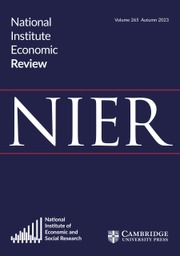No CrossRef data available.
Article contents
THE UK PRODUCTIVITY SHORTFALL IN AN ERA OF RISING LABOUR SUPPLY
Published online by Cambridge University Press: 19 February 2025
Abstract
Labour productivity stagnated in the UK in the period between the financial crisis and the emergence of Covid-19. Labour supply and employment grew strongly over the same period, driven primarily by net inward migration. While labour productivity should be independent of labour supply in the long run, this need not be the case in the medium run while capital per worker adjusts. Exploiting a range of evidence, we conclude that around 4 pp of the estimated 20% shortfall in productivity from its previous trend that had emerged by 2019 might be explained by increased labour supply, with a slowdown in TFP growth accounting for most of the shortfall.
- Type
- Research Article
- Information
- Copyright
- © The Author(s), 2025. Published by Cambridge University Press on behalf of National Institute Economic Review


